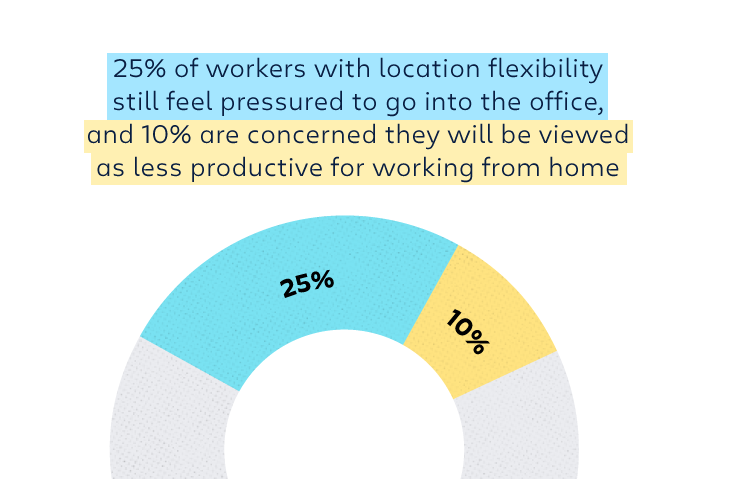Well-executed distributed work makes for happier, more productive teams
New research shows return-to-office mandates are not only unpopular among workers, but also ineffective.
5-second summary
- With 71% of knowledge workers working remotely at least once a week, most companies are already collaborating in a distributed way – but they’re not doing it well.
- Half of knowledge workers who go into the office are only doing so because of enforced mandates – not desire – and one in four say they feel pressured by leadership and their teammates to make a physical appearance.
- Workers with location flexibility and zero office mandate experience improved quality of life because they can structure their days differently, spending more time with friends and family, focusing on physical and mental health, and caring for loved ones.
The corporate world’s myopic focus on where work gets done is outdated. In order to evolve distributed work, we need to redirect our efforts towards how work gets done, in a way that benefits both workers and their organizations. Because in today’s world, most companies are already working in a distributed way, whether they realize it or not.
Regardless of how a company defines itself – remote, hybrid, in-office, you name it – the reality is this: modern work takes place across a distributed network. Companies with more than one office or any number of remote workers – not to mention clients or partners who work in a different location – are engaging in distributed work, faced with the challenge of connecting and communicating in ways that would have been impossible 50, 30, even 10 years ago. In the face of those challenges, the physical location of where your employees happen to work seems almost trivial.
How do we define “distributed work”?
Distributed work refers to any work happening in more than one place. This is how most knowledge workers already work, regardless of whether they spend time in an office or not. Information is shared and decisions are made across a connected virtual network.
At Atlassian, collaborating across distance and time zones is the norm – after all, our products make this possible for teams across the globe. We don’t need to be colocated or in an office to do our best work, but we care a whole lot about how the work gets done.
But when problems like low productivity or employee churn arise, we see companies using physical location as a scapegoat and forcing employees back into the office for at least some amount of time.
Based on a study we conducted with Wakefield Research of 1,000 knowledge workers in the US and Australia, the problem with distributed work is not the physical separation of employees. Rather, it’s that companies don’t have the right tools, norms, and ways of working in place, and are relying on practices that are better suited for in-person, in-office collaboration – and that’s a problem.
At Atlassian, we’re committed to distributed work for the long term. We have the flexibility and autonomy to choose where we work – in one of our offices, or not – on any given day. It’s up to us to figure out how to do this, and we firmly believe that when executed well, flexible distributed work is a better way to work – for organizations, their teams, and society at large.
Most companies are already distributed – but they’re not doing it well
Office mandate or not, our research found that 71% of knowledge workers work away from an office at least once per week. Yet only half of those workers (51%) say their company provides them with remote collaboration tools, which means a staggering proportion of companies offering full-time or part-time remote work are missing a key opportunity to enable collaboration across their distributed network.
Even worse, 26% of those who are provided with remote collaboration tools say they don’t necessarily have the right tools or adequate training on those tools to be effective.

Our takeaway is that an alarming number of knowledge workers don’t have the resources they need to be effective and efficient. And throwing a random assortment of video conferencing and messaging apps at the problem isn’t enough; teams don’t always know how to unlock the power of certain tools without adequate support and training on how best to use those tools in the first place.
And technology is just table stakes. Leaders must implement new ways of working to ensure that their teams have the time, clarity, and connections they need to move work forward in a distributed world. For many teams, this requires a fundamental shift in the way we work.
it starts at home
Atlassian’s mission is to unleash the potential of all teams – including our own. Today, 92% of Atlassians say flexibility to work from anywhere allows them to do their best work. But again, it’s not just location that enables this setup. We continuously experiment with our products and ways of working to make sure every Atlassian can work effectively.
We rely on our dynamic products and ever-evolving practices to support our Team Anywhere program:
Workers go to the office out of obligation – not because they want to
According to our survey, 82% of all knowledge workers have some form of “in-office mandate” today, and nearly half of these office-goers (46%) only go into the office because of these company mandates – not necessarily because they want to.
Even among workers who are supposedly able to choose whether they come into the office or not, 25% say they still feel pressure to go in. And 10% are concerned they will be viewed as less productive or uncommitted to their work if they work from home.

Our take? Leaders are pressuring employees to return to the office because they lack confidence and conviction in new approaches to work. But mandates won’t solve the problem. To be effective in today’s world, companies need to design and validate best practices for distributed work until teams are effectively collaborating and connecting, without relying solely on in-person time.
Atlassian offices are thriving
Today, 77% of Atlassians connect in person in our offices each quarter, and about half of the company visits an office at least one per month. Why? Because they want to. Our offices are a great place for Atlassians to connect, collaborate, and problem-solve, or hunker down for deep focus work.
To avoid putting pressure on employees, our executive team isn’t situated within one region. In fact, our executives intentionally work from home a lot of the time to encourage Atlassians to make the choice that works best for them, and relieve any invisible pressure that surfaces when executives are in-person.
And this isn’t to say that face-to-face connection with colleagues and leadership isn’t important. On the contrary, we wholeheartedly believe there are significant benefits to in-person team interaction – it just doesn’t need to happen every day to be effective.
Workers with flexibility enjoy better quality of life
The power of flexibility is much bigger than just saving commute time or doing a load of laundry during lunch hour. It’s a fundamental rebalancing of priorities in a person’s life.
- For all surveyed US knowledge workers, the number one reason for preferring remote work is that they are happier working from home (47%). Half of Gen Z (50%) and nearly as many Millennials (49%) say they are happier working from home, compared to 37% of Gen X workers and 37% of Baby Boomers.
- Among those surveyed without any mandated in-office time, 56% say they spend more time with friends and family, 49% spend more time on physical fitness or self-care, and 37% have pursued a new hobby or interest, specifically because they are not required to be in the office for a specified amount of time.
- In this same group, 20% have moved cities, 16% have purchased a home, and 12% have started families. These aren’t minor conveniences – these are core life changes workers were able to make because of flexibility.

We’re not saying flexibility means working less. But we are saying flexibility gives workers the ability to strengthen other areas of their lives. Internal Atlassian product data shows no evidence of decreasing productivity of Atlassian employees since we implemented Team Anywhere – in fact, our workdays are a bit longer than pre-pandemic. But that’s not because we’re working more or less. It’s because we can spread out our days to make time for other priorities in between.
With Team Anywhere, Atlassians choose where they prefer to work on a given day, and approximately 40% of Atlassians live two hours or more from an office. This policy has changed lives – full stop. Here’s how.
We know from our annual State of Teams report that employees who have the flexibility to work in the location of their choosing have significantly better outcomes related to innovation, well-being, burnout, and perceptions of organizational culture – all of which are strongly associated with higher employee retention rates. When workers have the option to work from home, they’re empowered to make more beneficial life changes. And when people are happier, their work improves, particularly as collaborators.
Most leaders can agree they want their teams to be innovative and effective, and report positive sentiment toward their organizational culture. Flexibility just so happens to be linked to these positive outcomes, too.
Most companies are already working in a distributed way, so it’s time to get really good at it.
Learning as we go
We’re still figuring out what well-executed distributed work looks like – same as every other company that has chosen this path. But we have yet to encounter a challenge that can’t be met by listening to our teams and updating our practices. At no point have we been tempted to roll out in-office mandates to address these issues.
The bottom line is this: most companies are already working in a distributed way, so it’s time to get really good at it. Every company needs to adopt the right tools and norms, and trust that good work can happen from anywhere.
Those who fail to experiment with new ways of working are at risk of falling behind. And companies that figure out how to get distributed right will be able to take full advantage of the business opportunity it offers: teams that produce higher quality work, answer harder questions, and move faster.
This new era of work is incredibly nuanced, and change is uncomfortable. No one said it would be easy, but the possibilities are extraordinary.











































